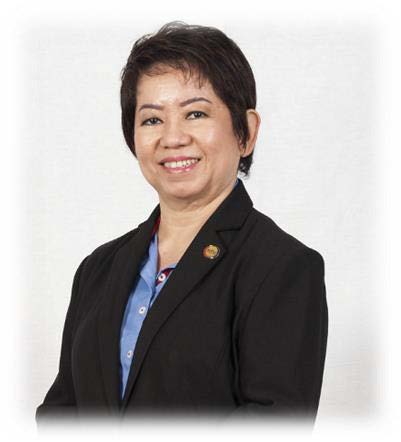 Ms Mah Lai Heng holds a degree in Nursing Sciences from University Malaya and completed her Advanced Critical Care Nursing training in the University South Australia. She obtained her Master’s degree in Business from the Henley Business School, University of Reading, United Kingdom, in 2009.
Ms Mah Lai Heng holds a degree in Nursing Sciences from University Malaya and completed her Advanced Critical Care Nursing training in the University South Australia. She obtained her Master’s degree in Business from the Henley Business School, University of Reading, United Kingdom, in 2009.
Ms Mah joined the East Malaysia Group of Hospitals as a Nursing Tutor at KPJ’s Putri Nursing College (now known as KPJ Healthcare University) in 1996. Throughout her tenure, she also taught Post Basic Programme in Critical Care Nursing as an adjunct lecturer at the University of South Australia, Adelaide. She held several positions in the Group, including General Manager to Kuching Specialist Hospital and Chief Executive Officer to KPJ Penang.
In 2012, she was appointed as the Senior General Manager of the KPJ Group Clinical & Quality Services. In Jan 2015, she stepped down from her role as Head of KPJ Group Clinical & Quality Services and was entrusted to focus on Business Operations as Executive Director for East Malaysia Group of Hospitals with the addition of Kuantan Specialist Hospital & KPJ Pahang.
She is also a facilitator and trained surveyor for Malaysian Society for Quality in Health since 2001.
Synopsis - Physician And Clinical Engagement: Optimizes Operational And Clinical Performance
In managing todays’ value-based healthcare, improving the delivery of care and reducing cost are critical component which Management would focus on. Hence it is necessary to consider creating an efficient and cost-effective approach in physician and clinical engagement.
There are many ways to establish Physician and Clinical engagement processes. One of which shall be establishing ‘clinical leadership’. Identifying physician champions may need to be prioritize. Get to know your Physician and clinical team. It is important to ‘lend a listening ear’, make them understand the organization Vision, keep them informed of the data review and to actively participate in corporate and clinical governing committees. The ultimate outcome where organizational processes supports better connectivity with physicians to decision making, developing strategy, and implementing change, the stronger the engagement with physicians becomes.
Prioritize Physicians involvement early in any strategic discussion, in a shared decision approach, and recognizing their participation especially in corporate and clinical governance bodies. Engagement with physicians, staff and patients are essential to making positive changes and sustainable improvements in healthcare organizations. This will be exhibited in better clinical outcomes, more positive patients’ experiences through efficient and effective care service delivery. Personals who are engaged feel respected, heard, valued, and empowered to contribute to and influence the delivery of healthcare services in the organization that they are involved in.
For any organization to achieve its Vision of providing outstanding care with efficient and effective operational and clinical performance, one will need the support of fully engaged physicians. This in turns need consistent leadership that embrace close relationship between physician advocacy and engagement in executing strong corporate and clinical governance compliance supported by a ‘just’ organizational culture.
Synopsis - Provider-Supplier Relationship: Opportunities For Improving Supply Chain Efficiency
In today’s global environment where ‘Internet of Things’ dominate, we still have to admit that the key to any success roadmap in Management cannot detach itself from the magical word ‘relationship’. This can determine whether we ‘make or break’ the business. We can be in any sector or services, we still need to establish key processes on building relationship which involves both technology and the ‘human factor’.
Building provider-supplier relationship to improve Supply Chain Efficiency shall not be side line too. This relationship process building includes areas of concern such as sourcing, design collaboration, negotiation, procurement, information exchange, etc. Consideration such as competitiveness, cooperativeness, sole sourcing need to be explored. All these aspects have to jive with the needs of the provider as well if both parties wants to achieve supply chain efficiency.
There are pertinent questions that many of the providers and suppliers need to engage with. How effective are we communicating?, Is our team members train comprehensively to align with the common goals?, How visible and how much do we share among ourselves?, Is customer needs examine for improvement?, How innovative are we to embrace changes?
Hence both provider and supplier need to consider a collaborative relationship. Transformational Strategies & process integration need to be driven to achieve results. Large Healthcare groups may need to consider establishing consolidated or centralised purchasing Service Centre. Synergizing on volume, gaining higher negotiation power, better pricing is achieved, practicing JIT, consignment tracks, provide the supplier a more enlarge market demand with narrower customer base to manage because of managing a focus point.
Processes can be enhance by adopting IT advancement eg adopting RFID applications, going to ‘real time’ orders and ‘door to door’ delivery. Enhancing more efficient processes thus error reduction, improve payment processes and improving cash flow and higher productivity once ‘needs’ are met.
Today Healthcare Providers are expected to manage diversified locations, changing organizational structures due to acquisition and merger exercise, multiple information system across the group/chain. Therefore HealthCare Providers and Suppliers have to come in congruent with their roles and responsibility to transform the supplier chain efficiency together to meet value added supply chain performance. Stay alert and be quick to adapt to the needs & demands at both ends to sustain a mutually beneficial relationship.